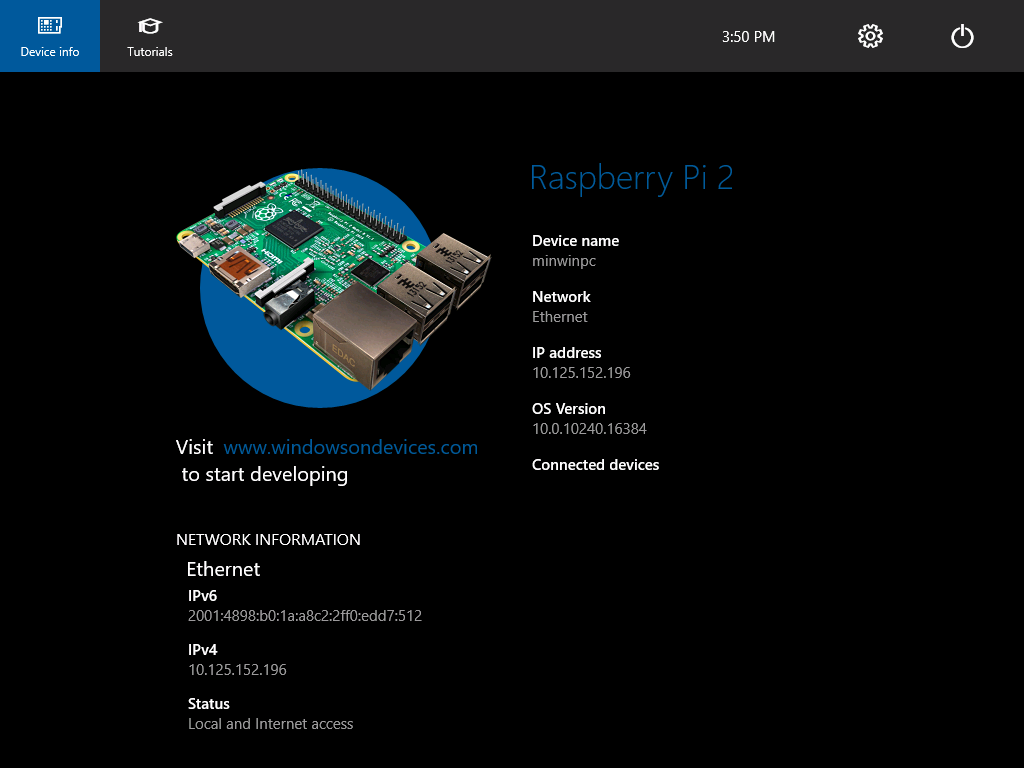Windows is an unlikely match for the credit card-sized Raspberry Pi computer.
But the Microsoft operating system more commonly associated with bulky desktops is now publicly available for the $35 Pi – which until recently primarily ran Linux-based software.
However, this is no ordinary version of Windows but rather Windows 10 IoT Core – a slimmed-down version of the OS aimed at Internet of Things (IoT) devices and which can be downloaded for free.

Here’s what you need to know about running Windows 10 on the Raspberry Pi.
Who’s this aimed at?
It’s primarily designed for developers and hardware hackers who want to prototype IoT appliances using the Pi.
What is Windows 10 IoT Core?
It’s not Windows as most people understand it. A fresh install of Windows 10 on the Raspberry Pi doesn’t boot to the familiar Windows desktop. Instead, Windows 10 IoT Core will show users a single full-screen Universal Windows app. The system will only display the interface of a single app at a time, although additional software can be run in the background. Apps are loaded onto the Pi from a Windows 10 desktop machine.
Which apps will it run?
As mentioned, this isn’t a replacement for your Windows desktop. If you’re looking for that on the Pi you’re better off sticking with something like the Linux-based Raspbian. Windows 10 on the Pi won’t run traditional Windows desktop applications with a graphical interface, such as Microsoft Word or Internet Explorer, as these are incompatible with the Pi’s ARM-based hardware.
What it will run are Universal Windows apps. These are apps that are written to run on many different types of devices – PCs, phones, tablets, Xboxes and IoT-related machines like the Pi. Universal Windows apps adapt their look and feel depending on which device they are running on – scaling back features where they are not supported by a particular platform but without breaking the app.
Windows 10 on the Pi should be able to run any Universal Windows app. Existing Windows Store apps for Windows 8 machines should also be able to be converted into Universal Windows apps, without “much effort”, according to Microsoft. While the Windows Store has faced criticism for the poor selection of apps on offer – there are still a wide variety of apps that could be ported – although the performance on the Pi’s smartphone-oriented hardware may vary.
However, Microsoft is primarily pushing Windows 10 IoT Core – which can run on hardware with or without screens – as an OS that makes it easier to create IoT devices. This aim of lowering the barrier to building appliances is complemented by the Pi’s low price and ability to control a range of hardware via its general-purpose input output (GPIO) pins.
What apps are available?
Microsoft’s IoT team and Pi-owners have been busy building since the preview of Windows 10 IoT Core was released for the Pi and other IoT boards in May this year.
Unsurprisingly, much of their efforts have been devoted to controlling robots, such as this rover, this air hockey playing automaton and this wheeled bot. Other creations include a home automation setup and a Pi-powered fan for keeping cool.
How can you make these apps?
Apps can be developed using Visual Studio 2015, Microsoft’s Integrated Development Environment for its platforms – whose Community edition can be downloaded for free. They can be written using a range of languages, such as C# or Visual Basic with XAML, JavaScript with HTML, or C++ with DirectX and/or Extensible Application Markup Language (XAML).
What else do you need?
You’ll need a PC running Windows 10, Build 10240 or later, to build and deploy apps to the Pi, as well as a Raspberry Pi 2 Model B board. However, some Pi owners claim it’s possible to deploy apps to the Pi from Windows 7 and 8 machines. The board can be accessed remotely via Windows PowerShell, as demonstrated in the guides linked below.
How can I get started with Windows 10 on the Pi?
There are already many good primers available on how to create and deploy apps to the Pi – such as this official Microsoft walkthrough or this guide to building an app to switch an LED on and off by Microsoft’s Scott Hanselman.
What’s the latest with Windows 10 on the Pi?
While a preview build of Windows 10 was released in May, Microsoft released the first public build on August 10. That build brings several improvements, including support for Wi-Fi and Bluetooth connectivity. The public Windows 10 IoT Core release also runs on other single-board machines – such as the Intel MinnowBoard Max.
Microsoft is also claiming this latest build improves support for Python and the Node.js JavaScript runtime, as well as delivering better performance when controlling hardware via the Pi’s GPIO pins.
It should also soon be simpler to get started building IoT devices for Windows 10 on the Pi, as there are plans to add Windows 10 IoT to the board’s NOOBS installer package – which makes it easier to get an operating system set up on the device.
More on Windows 10
- Patience will be the key to a successful Windows 10 upgrade
- Windows 10: The smart person’s guide
- How to upgrade to Windows 10: A step-by-step walkthrough
- Screenshots: Windows 10 alternatives that won’t disappoint